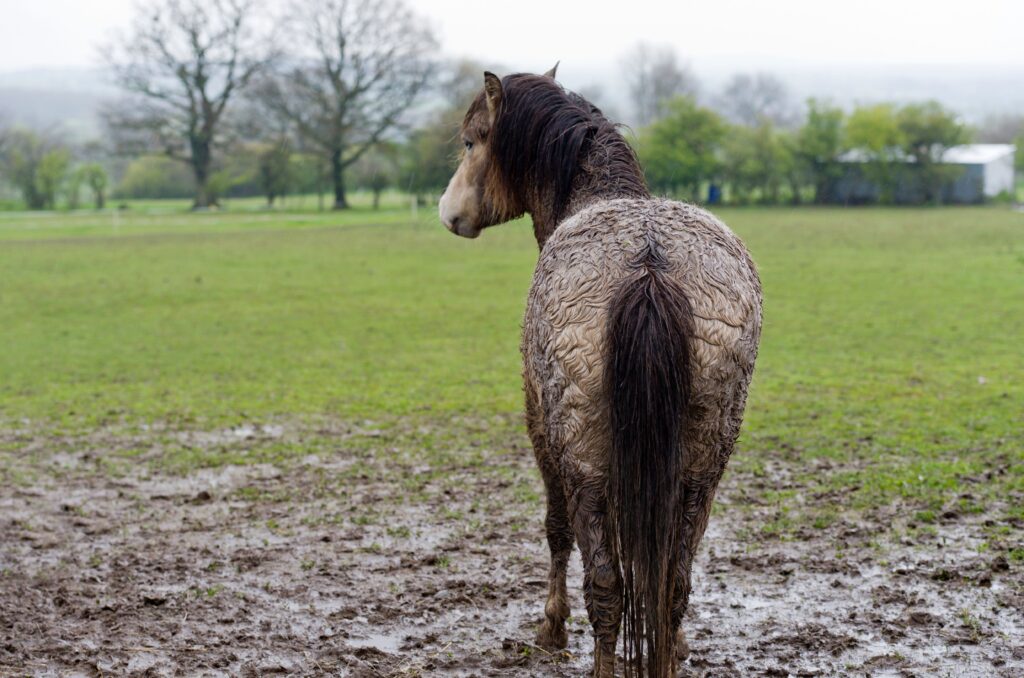Have you ever noticed your horse’s coat developing patches of scaly, crusty, or hairless skin after a rainy spell? It could be rain rot. Understanding the causes of this common skin condition can help you protect your equine companion and take the necessary steps to prevent and treat it effectively. At this point, you might be wondering: How do horses get rain rot?
Rain rot, also known as dermatophilosis, is a fungal infection that can affect horses. It is caused by a fungus called Dermatophilus congolensis, which thrives in damp and humid conditions. When the fungus comes into contact with a horse’s skin, it can cause an infection. The infection can cause circular patches of hair loss, scabs, and inflammation. In severe cases, it can also cause lameness.
While the brief answer gives you a general understanding of the cause of rain rot, continuing to read will provide you with valuable insights into preventing rain rot, identifying early symptoms, and effective treatment options. You’ll also learn about the potential complications and how to keep your horse’s skin healthy and protected, ensuring their overall well-being.

What are the Common Signs and Symptoms of Rain Rot?
Rain rot can manifest in various ways, and being able to identify its early signs is crucial for timely intervention. Common symptoms of rain rot include matted hair, scaly or crusty patches, hair loss, and raised, inflamed areas on the skin. These lesions may ooze pus and cause discomfort to your horse. By recognizing these signs, you can take immediate action to alleviate your horse’s discomfort and prevent the spread of the infection.
You’ll most often find rain rot on your horse’s back and hindquarters, but it can also appear on other places including their face and legs. My mare tends to get rain rot on her back legs, but I’ve also had a horse in the past who would get it on his back.
When rain rot appears on your horse’s pasterns, it’s usually called dew poisoning. Both dew poisoning and rain rot are caused by Dermatophilus congolensis.
What are Rain Rot Risk Factors?
Rain rot can be particularly problematic during the wetter seasons, but it’s not the only time when horses are susceptible to skin infections. Horses with compromised immune systems, poor nutrition, or those living in unsanitary conditions are more prone to developing rain rot.
Understanding the risk factors can help you implement preventive measures and create an environment that promotes optimal skin health for your equine companion.
How Do I Treat Rain Rot on My Horse?
When it comes to treating rain rot, early intervention is key. Mild cases of rain rot can often be managed through regular grooming, including gentle brushing to remove scabs and crusts, and keeping the affected area clean and dry. Antimicrobial shampoos or topical treatments prescribed by your veterinarian can help eliminate the bacteria and promote healing. In more severe cases, your vet may recommend systemic antibiotics or other specialized treatments, so it’s essential to consult a professional for an accurate diagnosis and tailored treatment plan.
Are There Any Preventive Measures to Protect Horses from Rain Rot?
Absolutely! Taking proactive measures can significantly reduce the risk of rain rot in horses. Start by providing a clean and dry living environment for your horse or pony. You should regularly remove manure and wet bedding from their stalls or paddocks to minimize the presence of bacteria. Ensure that your horse has access to shelter during rainy or humid weather to prevent prolonged exposure to damp conditions.
Maintaining good grooming practices is another essential aspect of rain rot prevention. Regularly brush your horse (especially in areas they’re prone to rain rot) to remove dirt, debris, and excess moisture from their coat. This helps improve air circulation and prevents the buildup of bacteria. Additionally, consider using waterproof blankets or sheets during wet weather to keep your horse’s coat dry and protected.
Supporting your horse’s overall health and immune system is also crucial. Provide a balanced diet that meets their nutritional needs, ensuring they receive adequate vitamins and minerals. Regular exercise and turnout time can help improve circulation and boost their immune system. Regular veterinary care, including vaccinations and deworming, can also contribute to your horse’s overall well-being and reduce their susceptibility to infections like rain rot.
By implementing these preventive measures, you can greatly reduce the chances of your horse developing rain rot and promote their overall skin health.
Is Rain Rot Contagious to Other Horses or Humans?
Rain rot is highly contagious between horses. If you have one horse with rain rot, you need to take protective measures to prevent it from spreading to other members of your herd. Don’t use grooming tools, tack or blankets on infected and uninfected horses. You should also wash your hands thoroughly after handling a horse with rain rot to prevent potential cross-contamination.
As for human transmission, the risk is generally low. Dermatophilus congolensis, the bacteria responsible for rain rot, is more adapted to infect equine skin than human skin. Nonetheless, it’s advisable to exercise caution and avoid direct contact with the infected areas of a horse’s skin. If you have any concerns about potential human exposure or if you experience any unusual skin symptoms after contact with an infected horse, consult a healthcare professional for appropriate advice.
The most important thing you can do is be proactive in preventing its occurrence. Implement the preventive measures discussed in this article, such as maintaining a clean and dry living environment, practicing good grooming habits, and supporting your horse’s overall health and immune system. By taking these steps, you can significantly reduce the likelihood of rain rot and ensure your horse’s skin remains healthy and free from infection. Remember, prevention is key when it comes to rain rot, so put your newfound knowledge into action and give your equine companion the best possible care.
